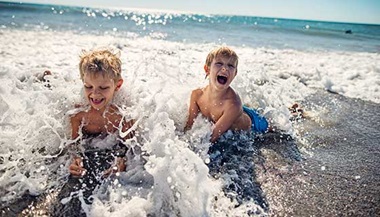Bites and Stings: Insects
Fleas, mites, and chiggers
Fleas, mites, and chiggers often bite humans, but are not poisonous. It is sometimes difficult to assess which type of insect caused the bite, or if the rash is caused by poison ivy or other skin conditions.
What are the symptoms of a flea, mite, or chigger bite?
The following are the most common symptoms of a flea, mite, or chigger bite. However, each individual may experience symptoms differently. Symptoms may include:
-
Small, raised skin lesions
-
Pain or itching
-
Dermatitis (inflammation of the skin)
-
Allergic-type reactions in hypersensitive people with swelling or blistering
The symptoms of a flea, mite, or chigger bite may resemble other conditions or medical problems. Always talk with your healthcare provider for a diagnosis.
Treatment for bites caused by fleas, mites and chiggers
Specific treatment for these insect bites will be discussed with you by your healthcare provider. Some general guidelines for treatment may include the following:
-
Clean the area well with soap and water.
-
Use an antihistamine, if needed, for itching.
-
Take acetaminophen, if needed, for discomfort.
When should I call my healthcare provider?
Call your healthcare provider if any, or all, of the following symptoms are present:
-
Persistent pain or itching
-
Signs of infection at the site, such as increased redness, warmth, swelling, or drainage
-
Fever
Call 911 or your local emergency medical service (EMS) if the individual has signs of a severe allergic reaction such as trouble breathing, tightness in the throat or chest, feeling faint, dizziness, hives, and/or nausea and vomiting.
Tick bites
Ticks are small insects that live in grass, bushes, wooded areas, and along seashores. They attach their bodies onto a human or animal host and prefer hairy areas such as the scalp, behind the ear, in the armpit and groin, and also between fingers and toes. Tick bites often happen at night and happen more in the spring and summer months.
What to do if you find a tick on your child
Recommendations for removing a tick include the following:
-
Do not touch the tick with your bare hand. If you do not have a pair of tweezers, take your child to your nearest healthcare facility where the tick can be removed safely.
-
Use a pair of tweezers to remove the tick. Grab the tick firmly by its mouth or head as close to your child's skin as possible.
-
Pull up slowly and steadily without twisting until it lets go. Do not squeeze the tick, and do not use petroleum jelly, solvents, knives, or a lit match to kill the tick.
-
Save the tick and place it in a plastic container or bag so it can be tested for disease, if necessary.
-
Wash the area of the bite well with soap and water and apply an antiseptic lotion or cream.
-
Call your child's healthcare provider to find out about follow-up care.
Regardless of how careful you are about animals in your home, or how many precautions you take when your child is outdoors playing, animal and insect bites and stings are sometimes unavoidable.
By remaining calm and knowing some basic first aid techniques, you can help your child overcome both the fear and the trauma of bites and stings.
Facts about insect stings
Bees, wasps, yellow jackets, and hornets belong to a class of insects called Hymenoptera. Most insect stings cause only minor discomfort. Stings can happen anywhere on the body and can be painful and frightening for a child. Yellow jackets cause the most allergic reactions in the U.S. Stings from these insects cause 3 to 4 times more deaths than poisonous snake bites, due to severe allergic reaction. Fire ants, usually found in southern states, can sting multiple times, and the sites are more likely to become infected.
The 2 greatest risks from most insect stings are allergic reaction (which can sometimes be fatal if the allergic reaction is severe enough) and infection (more common and less serious).
What are the symptoms of an insect sting?
The following are the most common symptoms of insect stings. However, each child may experience symptoms differently. Symptoms may include:
-
Local skin reactions at the site or surrounding the sting, including the following:
-
Pain
-
Swelling
-
Redness
-
Itching
-
Warmth
-
Small amounts of bleeding or drainage
-
Hives
-
-
Generalized symptoms that indicate a more serious and possibly life-threatening allergic reaction, including the following:
-
Coughing
-
Tickling in the throat
-
Tightness in the throat or chest
-
Breathing problems or wheezing
-
Nausea or vomiting
-
Dizziness or fainting
-
Sweating
-
Anxiety
-
Itching and rash elsewhere on the body, remote from the site of the sting
-
Treatment for stings
Specific treatment for stings will be discussed with you by your child's healthcare provider. Large local reactions usually do not lead to generalized reactions. However, they can be life-threatening if the sting happens in the mouth, nose, or throat area. This is due to swelling that can close off the airway.
Treatment for local skin reactions only may include:
-
Calm your child and let him or her know that you can help.
-
Remove the stinger, if present, by gently scraping across the site with a blunt-edged object, such as a credit card or dull knife. Do not try to pull it out, as this may release more venom.
-
Wash the area well with soap and water.
-
Apply a cold or ice pack wrapped in a cloth to help reduce swelling and pain (10 minutes on and 10 minutes off for 30 to 60 minutes).
-
If the sting happens on an arm or leg, elevate the limb to help reduce swelling.
-
To help reduce the itching, consider the following:
-
Apply a paste of baking soda and water and leave it on for 15 to 20 minutes.
-
Apply a paste of nonseasoned meat tenderizer and water and leave it on for 15 to 20 minutes.
-
Apply a wet tea bag and leave it on for 15 to 20 minutes.
-
Use an over-the-counter product made to use on insect stings.
-
Apply an antihistamine or corticosteroid cream or calamine lotion.
-
Give acetaminophen for pain.
-
Give an over-the-counter antihistamine, if approved by your child's healthcare provider. Be sure to follow dosage instructions carefully for your child.
-
Observe your child closely for the next hour for any signs of allergic reaction that would warrant emergency medical treatment.
-
Call 911 or your local emergency medical service (EMS) and seek emergency care immediately if your child is stung in the mouth, nose, or throat area, or for any signs of a systemic or generalized reaction.
Emergency medical treatment may include the following:
-
Intravenous (IV) antihistamines
-
Epinephrine
-
Corticosteroids or other medicines
-
Lab tests
-
Breathing support
Prevention of insect stings
Some general guidelines to help reduce the possibility of insect stings while outdoors include:
-
Avoid perfumes, hairsprays, and other scented products.
-
Avoid brightly colored clothing.
-
Do not let your child walk or play outside barefoot.
-
Spray your child's clothing with insect repellent made for children.
-
Make sure your child avoids locations of hives and nests. Have the nests removed by professionals.
-
Teach your child that if an insect comes near to stay calm and walk away slowly.
Some additional preventive measures for children who have a known or suspected allergy to stings include the following:
-
Carry a bee sting kit (such as EpiPen) at all times and make sure your child knows how to use it. These products are available by prescription.
-
Make sure your child wears long-sleeve shirts and long pants when playing outdoors.
-
See an allergist for allergy testing and treatment.





